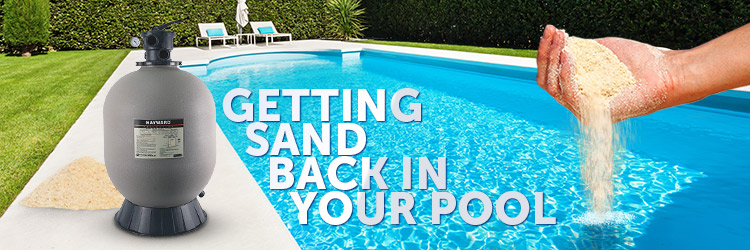If you’re finding sand in your pool because the sand filter media of your pool filter is somehow coming back through your pool’s return lines. And that’s a problem. It may mean that some section of your pool filter is broken or damaged and letting sand out. How can I prevent sand from returning to my pool after backwashing?
- Regularly inspect & backwash the filter
- Check for damaged O-rings, gaskets/seals
- Check the sand level & inside filter components
- Poor water chemistry
- Ensure proper backwashing technique
- Inspect the filter media for debris buildup/channeling.
- Check sand age
- Check the functionality of the multiport valve
Introduction:
Maintaining cleanliness in your pool is crucial for several reasons. Firstly, it ensures a safe and healthy swimming environment for you, your family, and your guests. Clean water reduces the risk of waterborne illnesses and infections, promoting enjoyable recreational experiences. Secondly, proper pool maintenance extends the lifespan of pool equipment and surfaces, saving you money on repairs and replacements in the long run. Additionally, a clean pool enhances the aesthetic appeal of your outdoor space, creating a more inviting atmosphere for relaxation and entertainment.
Despite diligent maintenance efforts, many pool owners encounter the frustrating problem of sand returning to the pool after backwashing. Backwashing is a necessary process for cleaning pool filters by reversing the flow of water to flush out trapped debris.
However, if not performed correctly or there are underlying issues with the filtration system, sand particles can escape into the pool, leading to cloudy water and clogged equipment. This recurring issue not only diminishes the visual appeal of the pool but also requires additional time and resources to rectify. Identifying the causes of sand return and implementing effective prevention measures are essential steps in maintaining a pristine and enjoyable swimming pool experience.
Prevention Methods for Sand Returning to My Pool After Backwashing
A. Proper Filter Maintenance
- Regular Filter Inspections:
- Check for signs of wear or damage to filter components.
- Inspect the filter media for debris buildup or channeling.
- Monitor water pressure to detect clogs or flow restrictions.
- Cleaning Techniques:
- Follow manufacturer’s guidelines for cleaning intervals.
- Use appropriate cleaning solutions and equipment.
- Rinse and backwash the filter as needed to remove trapped debris.
B. Checking for Damaged Components
- O-rings and Seals:
- Inspect O-rings and seals for cracks, deterioration, or misalignment.
- Replace damaged seals promptly to prevent leaks and sand bypass.
- Multiport Valve:
- Test the functionality of the multiport valve through all settings.
- Look for signs of leakage or damage around the valve assembly.
- Repair or replace faulty valves to ensure proper filtration operation.
C. Backwashing Technique
- Duration and Frequency:
- Backwash the filter according to recommended intervals based on pool usage and water conditions.
- Adjust backwashing frequency as needed during periods of heavy debris or algae growth.
- Proper Valve Settings:
- Set the multiport valve to the “backwash” position before initiating the backwashing process.
- Ensure proper valve alignment and secure connections to prevent leaks or sand bypass.
Conclusion:
In conclusion, preventing sand from returning to your pool after backwashing requires a combination of proactive measures aimed at maintaining the integrity of your filtration system and minimizing external factors that contribute to debris accumulation.
Key prevention methods include proper filter maintenance, regular inspections, checking for damaged components, employing correct backwashing techniques, using filter aids, monitoring pool chemistry, considering landscaping factors, and adhering to a consistent maintenance schedule.
Proactive maintenance is crucial for ensuring the long-term cleanliness and functionality of your pool. By regularly inspecting and servicing your pool equipment, addressing issues promptly, and implementing preventive measures, you can avoid costly repairs, prolong the lifespan of your filtration system, and preserve water quality. Proactive maintenance not only saves time and money but also enhances the overall enjoyment and safety of your swimming experience.
By following the prevention methods outlined in this guide and prioritizing proactive maintenance practices, you can create and maintain a clean, inviting, and sand-free pool environment. Enjoying crystal-clear water free of debris not only enhances the aesthetic appeal of your pool but also promotes a healthier and more enjoyable swimming experience for you, your family, and your guests. With proper care and attention, you can relax and unwind in the refreshing oasis of your own backyard, knowing that your pool is clean, clear, and ready for endless hours of enjoyment.
References:
Pool Parts to Go- Sand in Your Pool? Here’s Why—And How to Fix It
FAQ’s
- Why is sand returning to my pool after backwashing?
- Sand can return to the pool if there are issues with the filtration system, such as damaged components or improper backwashing techniques. Common culprits include worn-out filter media, damaged O-rings or seals, and faulty multiport valves.
- How can I prevent sand from returning to my pool?
- To prevent sand from returning, ensure proper filter maintenance, including regular inspections and cleaning. Check for damaged components like O-rings and seals, and maintain correct backwashing techniques, such as adjusting duration and valve settings. Consider using filter aids to enhance filtration efficiency.
- What should I do if I notice sand in my pool after backwashing?
- If sand is present in your pool after backwashing, it’s important to identify and address the underlying cause promptly. Start by inspecting the filtration system for any signs of damage or malfunction. Clean or replace damaged components as needed, and adjust your backwashing technique to ensure effective debris removal.
- Can poor water chemistry contribute to sand returning to the pool?
- Yes, poor water chemistry can exacerbate filtration issues and contribute to sand returning to the pool. Imbalanced pH, alkalinity, or sanitizer levels can lead to scale formation, biofilm buildup, and filter clogging, reducing filtration efficiency and increasing the likelihood of sand ingress.
- How often should I backwash my pool to prevent sand buildup?
- The frequency of backwashing depends on factors such as pool usage, water conditions, and filter type. Generally, it’s recommended to backwash the pool when the filter’s pressure gauge reads 8-10 psi above its clean pressure. Additionally, adjust the backwashing frequency as needed during periods of heavy debris accumulation.
- Are there landscaping considerations that can help prevent sand from entering the pool?
- Yes, landscaping choices can impact the amount of debris entering the pool. Avoid planting trees or shrubs with excessive foliage near the pool, as fallen leaves and debris can clog filters. Consider installing barriers like fences or screens to minimize windblown debris, and regularly trim vegetation to reduce debris accumulation.





